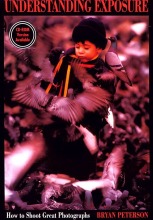Digital
101 Exposure Part 2
In
conjunction with the Nikon Talk Forum
at DP Review
Exposure
Metering Systems-How they work...
In
part one we reviewed how metering systems worked on an 18% reflectance,
which takes the whole frame into consideration in making an exposure.
For 80% of your pictures this works fine, but for the other 20% which
has a variety of conditions this will not result in a proper exposure.
In part two we will look at the different types of meter types.
The
typical camera manual is designed to tell you how the camera works. They
hardly ever tell you how the camera works to take a picture. Gee maybe a
photographer should write the manuals. Wow what a radical concept. But
itís true so for months you wonder around with your first camera that
has all the settings not knowing how to use any of them properly.
Metering
Types
The
first metering type is center
weighted. The center weighted metering system will have metering
emphasis in the center of the frame. Since the subject is always in the
center of frame if is thought that by putting the most of the emphasis
on the center this will result in a good exposure. This was the main
metering system for years in 35mm cameras and as you know the subject is
always in the center. No way Jose.
Next
there is the matrix metering.
This means you can take a photo will bending over backwards dodging
bullets in between jumping from building to building. Sorry I think I
got confused with a movie. With
Matrix metering the frame is divided into many segments. The metering
system will look at each segment and then average them all together for
the final exposure. Most metering systems use some type of this system
for the primary exposure settings on your camera. The amount of segments
vary from camera to camera and this metering system generally gives
better exposures than center weighted.
Spot
metering
is an over looked and seldom used metering system on most cameras. That
is a shame because in most of the 20% of your pictures that have some
kind of difficult lighting the spot metering is very useful. With the
spot metering the camera only looks at the center of the frame and all
of the exposure is based on this center 5 to 9% of the viewfinder. Let's
say you are going to a concert. Most concerts are at night either
indoors or outdoors. But one thing remains the same the background is
generally dark and the band is in the spotlights. The exposure meter on
your camera will look at the whole frame and see all this dark area and
try to calculate it into the exposure.
This will result in a longer then necessary exposure in which the
entertainers will be overexposed and sometimes burned up with no detail.
If
you take your camera and put it in the spot metering mode then get as
close to the entertainer as possible and the use your zoom to fill the
frame with the subject. If you are close enough you have now eliminated
the background from the photo. Now take an exposure reading with the
camera in the spot mode. This exposure is based on the subject only.
Take two readings, one in the brightest spot, one in the lower light
spots the dark blues or reds. You might ask put why do this, since as
soon as you move back these settings will change. Manual exposure is
made to order. Let's say you took your readings and the bright light was
f4 at 1/125th of a second and the low light was f4 at 1/60th of a
second. You set either of these exposure settings in the manual mode and
the camera will not change the exposure. Now it makes no difference if
you are 10 feet or 50 feet from the stage your exposures will be close
to the same. Distance has a filtering effect on light so you may have to
add a little exposure if you are far from the stage but setting the
basic exposure in manual will get you good images.
There
are a few 35mm camera that have multi spot metering which allows you to
take spot readings from multiple spots in the viewfinder. The camera
then averages then all together to come up with the final exposure. This
is a great metering system and works like a hand held light meter. But
it is too expensive to be an option on only the most expensive cameras.
Iím
going to stop here for tonight and the next post should be Sunday night.
We will look at the various metering on your camera such as aperture
priority, shutter priority, and exposure compensation and the automatic
modes and how to use each.
Then
we will look at difficult lighting situations such as backlighting, side
lighting, dark subject light background and the reverse of light subject
dark background. For homework I would recommend a search of Dirk
Vermeirre posts. All photographers have their individual strengths. Some
can see an image that others would pass by, some see light better than
others, and some are good with exposures. Dirk takes images that are
dramatic because of his use of light to make the image more powerful. He
also takes images of animals at the zoo that make you forget these are
zoo pictures. He captures personalities and emotion. Dirk and Jarrell
Conley are the first posts I open in the forum. Find those individuals
that inspire you and learn from them.
More
soon.
Troutman
Click
here to discuss this tutorial on the Nikon Talk Forum at DPReview...
<<
[ Back ] [ Next ]
>>
|
For
further reading...
Take a look at "Understanding
Exposure"
by Bryan Peterson.
 |
 |
| Front
Cover |
Back
Cover |
"If
you're someone who finds the concept of exposure overwhelming
and confusing, then Understanding Exposure is the book you've
been waiting for. Professional photographer Bryan Peterson
demystifies this complex subject, making it easy to grasp."
(taken from the back cover)
This
144 page book also includes more than 100 side-by-side
comparison pictures.
Click
here for more details and to purchse
|
